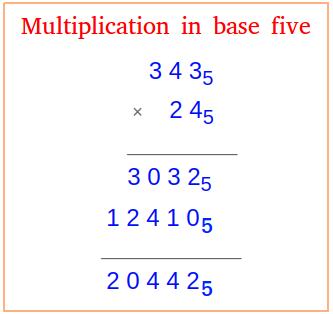Multiplication in Base 5
Multiplication in base five can be challenging. However, I will try my best to break the information down into into steps to make it easy to understand and master.
It is similar to multiplying numbers in base 10. However, because we are not used to do this in base 5, it may appear tough.
Plan to spend some time reading this lesson about multiplication in base five more than once.
First, know the difference between base 5 place value and base 10 place value.
I show the difference with two numbers: 48573 and 134125
For 48573, 5 is in the hundreds place and it means there are 5 hundreds
For 134125, 4 is in the twenty-fives place and it means there are 4 twenty-fives

The most difficult concept with multiplication in base five is to master how to carry numbers.
Study the following two multiplications carefully. The one on the right is the multiplication in base five.
Example showing how to do multiplication in base 5
Example 2:
Step 2:
4 × 4 = 16.
16 + 2 = 18 fives
18 fives = 5 fives + 5 fives + 5 fives + 3 fives
= 25 + 25 + 25 + 15
= 25 + 25 + 25 + 3 fives
You have 3 twenty-fives to carry. Write 3 down in the fives place and carry 3 twenty-fives by putting 3 in the twenty-fives place (Shown in green)
Step 3:
4 × 3 = 12.
12 + 3 = 15 twenty-fives
15 twenty-fives = 5 twenty-fives + 5 twenty-fives + 5 twenty-fives + 0 twenty-five
= 125 + 125 + 125 + 0
= 125 + 125 + 125 + 0 twenty-five
You have 3 one hundred twenty-fives to carry. Write 0 down in the twenty fives place and carry 3 one hundred twenty-fives by putting 3 in the one hundred twenty-five place (Shown in black)
Bring down the 3 in the one hundred twenty-fives place.
Notice again the 0 in the twenty-fives place.
1 1 1
3 4 35
× 2 05
_______________
1 2 4 1 05
Step 4:
2 × 3 = 6 fives.
6 fives = 5 fives + 1 five = 25 + 1 five
Carry 1 twenty five by putting 1 in the twenty-fives place (Shown in red)
Write 1 down in the fives place.
Since there is nothing in the ones place, just put a 0.
Step 5:
2 × 4 = 8 twenty-fives.
8 twenty-fives + 1 twenty-five = 9 twenty-fives
9 twenty-fives = 5 twenty-fives + 4 twenty-fives
= 125 + 4 twenty-fives
Write 4 down in the twenty-fives place and carry 1 one hundred twenty-five by putting 1 in the one hundred twenty-five place (Shown in green)
Step 6:
2 × 3 = 6 one hundred twenty-fives.
6 one hundred twenty-fives + 1 one hundred twenty five = 7 one hundred twenty-fives
7 one hundred twenty-fives = 5 one hundred twenty-fives + 2 one hundred twenty-five = 625 + 2 one hundred twenty-five
Write 2 down in the one hundred twenty-fives place and carry 1 six hundred twenty-five by putting 1 in the six hundred twenty-five place (Shown in black)
Just add now. Adding the results in base five.
1
3 0 3 2
1 2 4 1 0
______________
2 0 4 4 2
